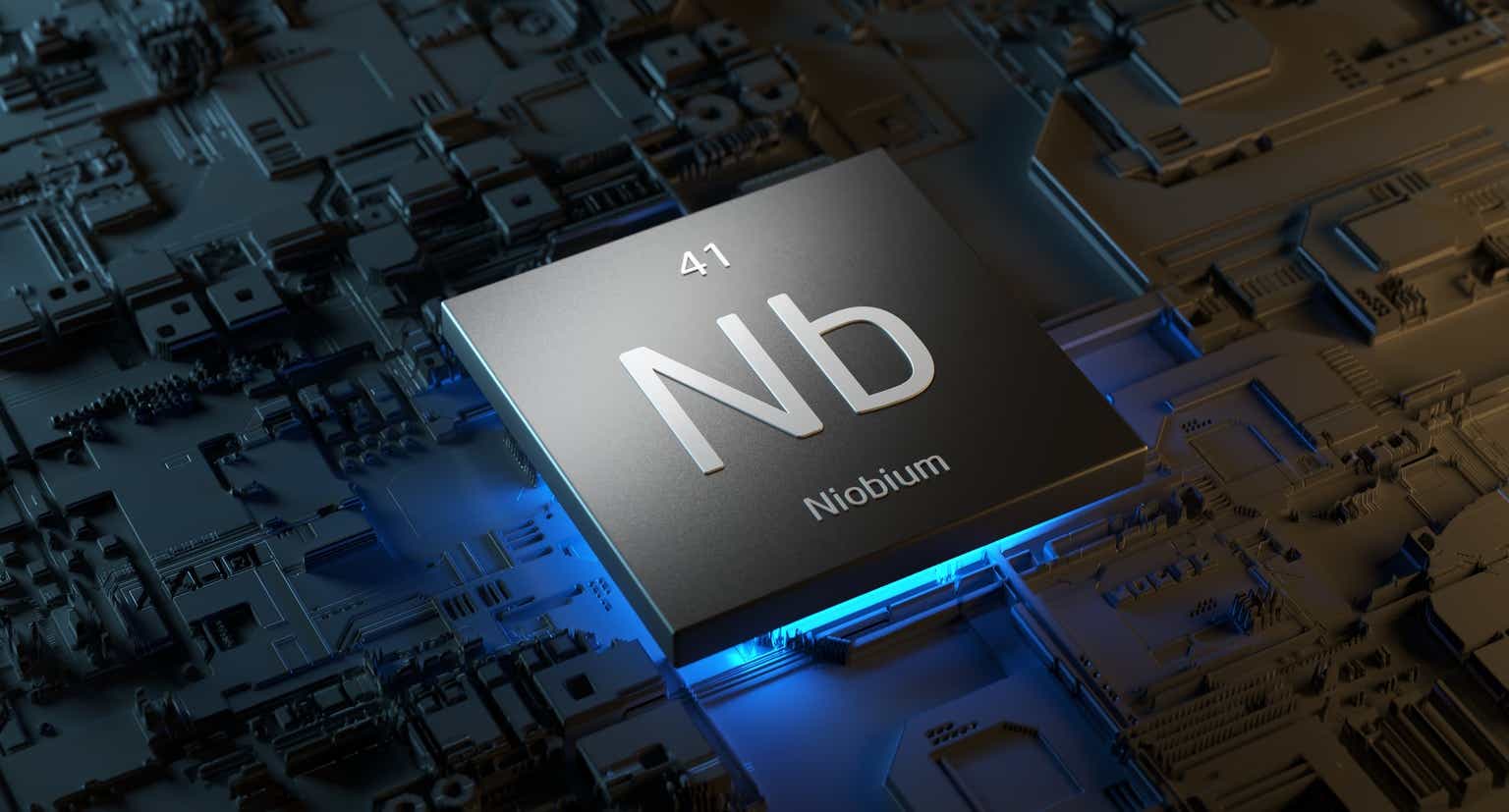Preamble
Rare earth elements are in the news these days for their wondrous chemical properties. They have the kind of names any marketing department within a top tier pharmaceutical company would be proud of. For instance, dysprosium sounds for all the world like a medication to treat some kind of mental disorder. Given the keen interest by investors in elements with strange names, it’s puzzling why niobium, another highly valued metal, remains relatively obscure despite its growing demand. Could it be that the lack of interest is due to the difficulty in investing in a miner that produces the metal? Indeed, the biggest miner of the metal, Companhia Brasileira de Metalurgia e Mineração (CBMM), supplies the world in the order of 85% of demand and is not available to retail investors. Furthermore, the only other significant miner of the metal is a Chinese company, CMOC Group Limited, whose Niobium mine is also in Brazil.
Given that Niobium demand is expected to rise and that there are few options to invest in this element, many investors have become excited about NioCorp. However, in my opinion, their excitement is misplaced; at least for the next 3 years.
Niobium
To understand why Niobium is in demand, it would be useful to consider the many uses to which it is put and to consider its unique properties. Niobium, a rare and remarkable metal, plays a pivotal role in various industries, owing to its unique properties that enhance the performance and longevity of the alloy produced. One of its primary alloys is stainless steel, where niobium significantly elevates the strength, toughness, and corrosion resistance. This attribute ensures it is indispensable in several sectors, including aerospace, automotive, construction, and energy. For instance, in the aerospace sector, niobium finds widespread use in jet engines due to its remarkable strength, high-temperature resistance, and low weight.
A conspicuous trend is the rising importance of niobium in semiconductor applications. In view of its impressive properties, including a high melting point, excellent electrical conductivity, chemical stability, low thermal expansion coefficient, and the ability to form thin films, demand is surging. And niobium’s role is set to expand, especially in advanced devices such as the next-generation DRAM chips and flash memory chips.
NioCorp
NioCorp Developments Ltd. is a Canadian mining company that is developing the Elk Creek niobium project in Nebraska, USA. The Elk Creek project is believed to be one of the largest known niobium deposits outside of Brazil. The project is also expected to produce significant quantities of Scandium, Titanium, and rare earth elements. However, the focus of this article is niobium.
According to the NioCorp Developments Ltd. website, the Elk Creek Superalloy Materials Project is expected to produce around, 7,055 tonnes of niobium per year in the form of ferroniobium. The website also states that the project has a mine life of 38 years. This quantity of niobium roughly equates to the amount currently consumed by the US, according to a government report (Page 125), which states; “In 2022, U.S. niobium apparent consumption (measured in niobium content) was estimated to be 7,600 tons, a 4% increase from that in 2021”.
Current supply
By some estimates niobium demand is expected to increase by CAGR 10%. Whereas others suggest a more modest CAGR of 3.78%. Although, there is no shortage of niobium at present. The USGS also estimates that “world resources of niobium are more than adequate to supply projected needs”. This is understandable since some niobium miners have excess capacity. Indeed, some niobium miners already have excess capacity to meet expected rising requirements. For instance, Brazil’s CBMM alone has increased capacity to 150,000 tons, which represents a CAGR of 5.11% over 10 years (CAGR = (150,000 / 100,000) ^ (1 / 10) – 1). Also, the Niobec mine sold by IAMGOLD to Magris Resources Inc had a history of increasing production by over 10% per annum.
Furthermore, companies are developing technologies that enable niobium to be recycled, thus reducing the necessity for mined metal.
Given the above, one may reasonably expect that additional supplies onto the world market may prove to be a drag on the price of niobium, and thus reduce the profitability of niobium miners.
NioCorp
If you take a look at NioCorp’s latest form 10-Q, you will note that there is around $7 million in cash, which clearly means that the company needs to raise an awful lot of money to develop Elk Creek. In fact, if you take a trip to the company’s overview of the project, it is estimated that around $800 Million will need to be raised. NioCorp is planning to raise the balance of the funding necessary for the project through a combination of debt and equity financing.
In addition to debt and equity financing, NioCorp is also exploring the possibility of receiving government grants or tax breaks to help finance the project. The company has already applied for a $30 million grant from the U.S. Department of Energy’s Advanced Technology Vehicle Manufacturing Loan Program, and is also in discussions with Nebraska about potential tax breaks.
As I see it, an equity raise by NioCorp would affect existing shareholders in two primary ways. To begin with, it would result in share dilution, reducing the percentage of ownership represented by each existing share. In addition, the immediate impact on the company’s stock price would likely be negative as investors might worry about ownership dilution and the company’s ability to secure the necessary capital.
Additionally, given the current economic uncertainty, there is always the risk of the company not being able to raise the necessary capital to fully develop the Elk Creek project.
Other risks
Elk Creek is by no means the only new niobium source. In fact, some deposits are further advanced and have a greater capacity than Elk Creek. The Taseko Mines’ (TGB) niobium deposit, known as Aley, is expected to produce 9,000 tons of Niobium per year over its 24-year mine life. Taseko Mines is currently working on a feasibility study for the project, and, if the study is successful, the company could begin construction on the mine as early as 2026. Furthermore, Taseko Mines has a tad more than $7 million in the bank together with revenue from their other mining operations, so there is less risk of a large equity raise.
Then we must consider current suppliers and whether there is the possibility that CBMM’s mine, Araxa, could begin to wind down. This is far from likely. According to a recent article, it would appear that “Brazil has approximately 98% of the known reserves in the world, followed by Canada and Australia. A survey by the National Mining Department (DNPM), which was superseded in 2018 by the National Mining Agency (ANM), placed the proven reserves in Brazil at 842.4 million metric tons. Of the total reserves in the country, 75% are in Araxa”. In other words, Araxa can increase production still further and still be in operation for many decades.
Risks associated with a short position
Well, there are the usual assortments of geopolitical risks. The Brazilian government may require suppliers to restrict supply in order to boost the price. Also, given that Brazil is a member of BRICS, other potential restrictions to supply may emerge.
Far and away the biggest risk is that the potential future reward for investors may become more apparent. If one does a back of the envelope calculation, the potential financial gain for patient investors does look appealing.
Back in 2014, IAMGOLD sold its Niobec niobium mine to a group of companies led by investment firm Magris Resources Inc for US$530 million. At the time, this fully functioning mine had a similar profile to the Elk Creek project: A 40 year mine life and producing around 5,000 tons of niobium annually. If we assume that Elk Creek will be operational in 10 years it may be roughly valued at US$530 million with a CAGR of 5% over 18 years, which gives us $1.44 billion.
If one considers NioCorp’s Elk Creek Feasibility Study; “the Project has a Pre-Tax Net Present Value of $2.8 billion, a pre-tax Internal Rate of Return of 29.2%, and a relatively long mine life of 38 years”. If indeed, the mine requires $800 million to develop, it looks to be a good investment over the long term.
Finally, despite the poor economic outlook, it is always possible that NioCorp could raise the money to develop their deposit ahead of schedule.
Summary
It is believed that the Elk Creek project will produce around 7,055 tonnes of ferroniobium as the primary product plus 102 tonnes of scandium trioxide and 12,000 tonnes of titanium dioxide annually over its 38-year operating life. However, to develop this deposit, the company has stated that there will likely be an equity raise, leading to share dilution for existing shareholders. Once the money is raised, according to the feasibility study (page 517), it could be more than 3 years before the mine is in production and the company begins to see some revenue.
In my view, the world’s leading producers can easily ramp up production to meet demand thus negating the requirement for additional supplies.
It is likely that NioCorp will prove to be a worthy investment, but, as far as I can see, certainly not in the short-term.
Note
I have a short position in NioCorp, and so, as always, investors ought to carry out their own due diligence.
Read the full article here









Leave a Reply